To most people living in big cities, using the internet at speeds of 10 Mbps or lower, is unacceptable. But if you’re living in certain parts of rural America, 10 Mbps could be considered quite a lot. So, is 10 Mbps fast or slow? Well, it depends on where you live and how you use the internet. To answer this question, we will list all the most common internet activities, compare recommended speeds for those activities, and see if 10 Mbps meets the required speeds. Let’s start with some basic everyday terminology related to internet speed and bandwidth.
CONTENTS
Internet Speed Terminology
Is Speed the Same Thing as Bandwidth?
No, they are not, even though we all use them interchangeably. Even ISPs do that every day. So, what’s the difference?
When we discuss speeds and talk about Mbps, we are actually talking about bandwidth. Bandwidth is the measure of capacity of your internet connection. It tells us the max data rate that your internet connection can handle.
Bandwidth and internet speed explained
Besides bandwidth, you should also know about throughput. This is the actual data rate that your internet connection can handle at some point in time. So, you can say that bandwidth is the max capacity, while throughput is the real-life capacity. Real-life capacity is usually lower than the bandwidth that you are paying for. All the online speed tests (like Ookla Speedtest) measure the throughput of your internet connection. They don’t measure speed, even though they are called speed tests.
So, what’s speed then? We can only talk about speed in terms of the response time of your connection – speed is closely related to latency.
We all use the term speed when actually talking about bandwidth and we usually say that the connection is faster if you have more Mbps. While the correct way would be to say that the connection has greater bandwidth, it’s not a big deal if you are using terms speed and bandwidth interchangeably.
Mbps and MB/sec
Mbps (Megabit per second) is the unit used to measure bandwidth (data rate per unit of time). More Mbps equals higher bandwidth and, colloquially, higher download speeds. MB/sec (Megabyte per second) or MBps also measures data rate, but it’s not the same thing as Mbps – it’s 8x greater than Mbps. While internet plans are always advertised in Mbps, our computers often use MB/sec to measure the data rate at which the transfer or download of some file is done. Online speed tests also display the results in Mbps, not MB/sec.
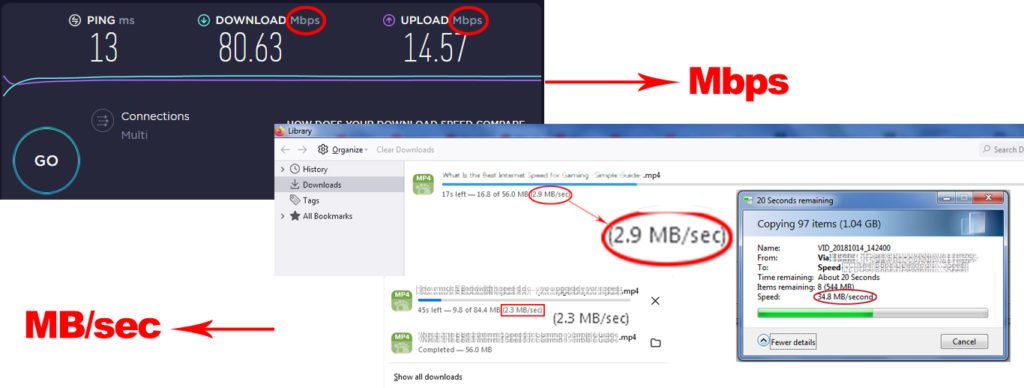
What is Broadband Internet?
Not every internet connection, regardless of the speed, can be considered broadband internet. In the US, we have an official definition of broadband internet created by the FCC 6 years ago. The FCC defines minimum download and upload speeds for an internet connection to be considered broadband internet. Those benchmark speeds are 25 Mbps download and 3 Mbps upload.
While most of us consider these speeds too slow and insufficient for our daily activities, not all parts of the US have access to broadband internet. In fact, you have millions of people all over the US (mostly in rural areas), that use the internet at much lower speeds. In some areas of the US, you can’t get speeds higher than 10 Mbps. FCC publishes Broadband Progress Reports every year. Through these reports, you can follow the implementation of broadband internet in the US. We will discuss these reports and the availability of broadband internet in one of the following sections.
Internet Connection Types
There are 6 major types of internet connection, 5 of which are used today:
- Cable
- Fiber
- DSL (ADSL, SDSL, VDSL, etc.)
- Fixed wireless
- Satellite
- BPL (Broadband over Powerlines)
Each type of connection has its flaws and its advantages, but we can still say that some are better than others, mostly because of the speeds they deliver. Cable and fiber are, by far, the most desirable connection types. At the moment, both cable and fiber can deliver download speeds of up to 1 Gbps (fiber can go well over that). Cable offers much lower upload speeds, while fiber plans are symmetrical and deliver amazing upload speeds. These two connection types are the most popular in big cities.

When it comes to rural parts of the US, the availability of cable and fiber is very limited. ISPs simply don’t see economical interest in developing cable/fiber infrastructure in places where the population density is low. So, people in these areas usually get to choose between DSL (based on existing telephone lines), fixed wireless, or satellite internet. The problem with these connection types (or rather one of the problems) is that the max speeds (both download and upload) are much lower than the cable and fiber speeds.
Internet Coverage and Average Internet Speeds in the US
We have already said a few words about coverage and speeds in the US, but let’s dig a little bit deeper and see what is considered good and bad when it comes to speeds and coverage.
There’re 313 million internet users in the US, which makes more than 90% of the population. That’s the number of users, not the number of people with some kind of internet access.
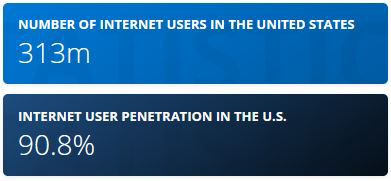
This number, however, doesn’t tell us how many people have access to broadband internet. If someone is using the internet at speeds of 3 Mbps, or 5 Mbps, or 10 Mbps, he/she is an internet user but doesn’t have broadband internet because those speeds don’t meet broadband internet benchmark speeds (25/3 Mbps). To find this information, we have to go through some FCC reports.
The latest FCC report regarding broadband deployment was published this year in January. The data from the report shows that more than 95% of the US population has access to broadband internet (urban – 98.8%, rural – 82.7%). This means that less than 5 percent of the US population doesn’t have broadband internet access – that’ more than 14 million people.

In the same report, you can find data about the availability of 10/1 Mbps. The numbers and percentages are naturally, a little bit higher (97.8% of the US population has access to speeds of at least 10/1 Mbps), but we still have 2.2% of the US population (that’s 7.2 million people) that doesn’t even have access to 10 Mbps or don’t have any kind of internet access. For them, 10 Mbps is probably fast.

The latest FCC report tells us how many people have access to broadband internet, but not how many people actually use the internet at broadband or higher rates. According to a Microsoft annual report on connecting rural America (2019), the number of people who use the internet at speeds lower than 25/3 Mbps, is much larger than you would assume based on the FCC report. According to Microsoft data, more than 150 million people in the US don’t use the internet at 25/3 or higher speeds.
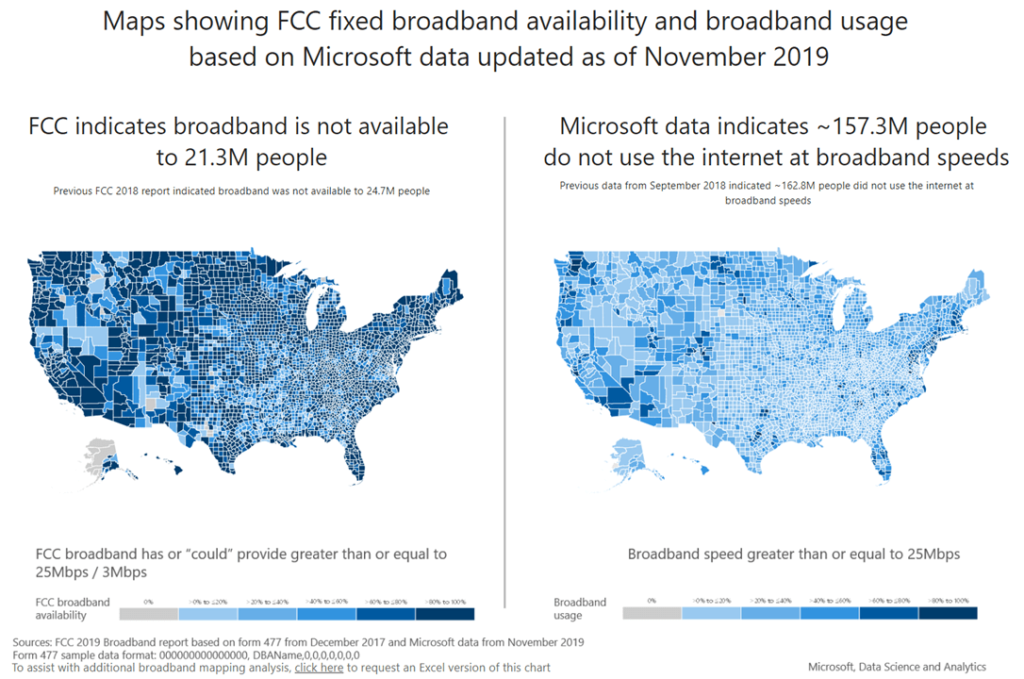
The situation has probably changed significantly over the past two years, especially considering the situation with COVID-19 and the fact that so many people had to work from home, but we still have millions of people who use the internet at speeds lower than 25/3.
The average internet speeds in the US are another topic we would like to cover. Over the last decade, the average internet speeds have been increasing exponentially. The last two (or rather four) years, brought us to a completely different level. In 2011, the average download speed was 4.73 Mbps. In 2017, it was 18.75 Mbps.
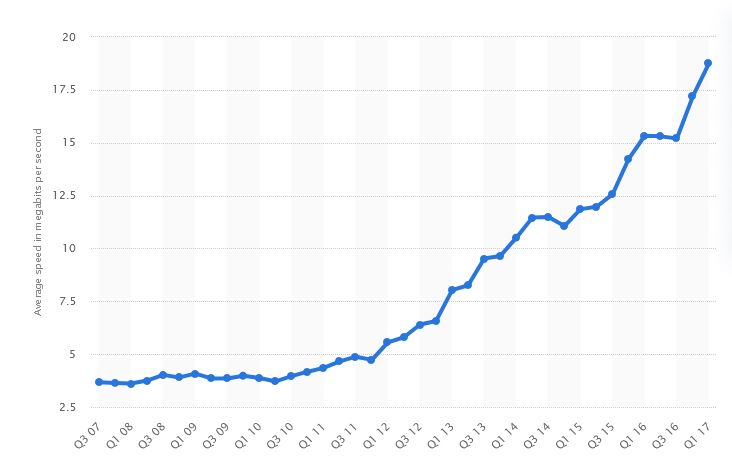
In just four years, we went from 18.75 to 99.3 Mbps (highspeedinternet.com) or maybe even 203.8 Mbps, according to Ookla Speedtest. Median internet speeds for US states (Ookla Speedtest) range from 51.47 (Wyoming) to 158.19 Mbps (New Jersey), which gives us median download speed for the entire US of approx. 112 Mbps, which is much closer to the value published by highspeedinternet.com.
Such an increase in average internet speeds is perfectly logical when you consider all the technological advancements and other conditions (especially lifestyle changes over 2020 and 2021). Fiber internet and Gigabit speeds are available to more than 40% of the population. More than half of the entire population has access to speeds higher than 500 Mbps (either through fiber or cable). The biggest fiber and cable ISPs (Verizon Fios, AT&T, Xfinity, Cox, Spectrum) are expanding their coverage every single day.
The fact that the speeds are increasing constantly is great, but there’s one problem that you don’t really think about. The gap between speeds in urban and rural areas is getting bigger and bigger. While you may live in NY and have 500/500 Mbps, someone living in Hyden, Kentucky can only get 5/1 Mbps. Your average may be 252.5 Mbps, but that doesn’t mean a thing to that guy from Hyden.
One of the biggest reasons why people in rural areas use the internet at much lower speeds is bad infrastructure that can’t handle higher speeds. However, that’s not the only reason. We also have the prices.
Internet Prices in the US
Internet in the US is not cheap at all, not even in bigger cities where you have multiple ISPs competing with each other. But the situation is much worse in rural areas. Why? Well, because there’s rarely any competition. Quite often, you will have only one ISP, and you will have to accept any deal they offer.
The price of the internet in rural America could be justified (partially) by the price of infrastructure. However, people in rural areas are often forced to use DSL, fixed wireless, or satellite internet, and they usually have to pay for the equipment. So, the only explanation why the internet prices are so high in rural America is because ISPs hold a monopoly.
Here’s the AT&T example – a customer subscribed to DSL Internet 10 has to pay $45/month. A person living in one of the cities with AT&T Fiber subscribed to Fiber Internet 500 (500/500 Mbps) also has to pay $45/month. A person living in an area without DSL or fiber can only use AT&T fixed wireless internet and has to pay $70/month, while the min guaranteed speed is 10 Mbps. So, if you are an AT&T DSL customer, you will be paying $4.5 per Mbps. If you’re subscribed to fixed wireless you will have to pay $7 per Mbps, and if you are a fiber customer, the price of a Mbps is only $0.09 per Mbps. That’s a huge difference!
What Kind of Speed Do I Need For…?
Minimum recommendations may vary depending on who you ask. Let’s see what relevant sources like FCC and streaming platforms recommend for their streaming services. Have in mind that these recommendations are only bare minimums and that they refer to only one device. If there are multiple devices in your home and if you (or some other family member) are going to use those devices at the same time for the same purpose, you have to multiply the recommended speed with the number of devices.
FCC Recommendations
Many people would say that FCC recommendations are too low just like many people think that benchmark speeds for broadband internet should be changed, but don’t forget that millions of people all over the US don’t have access to those speeds. Once again, the following recommendations are bare minimums.
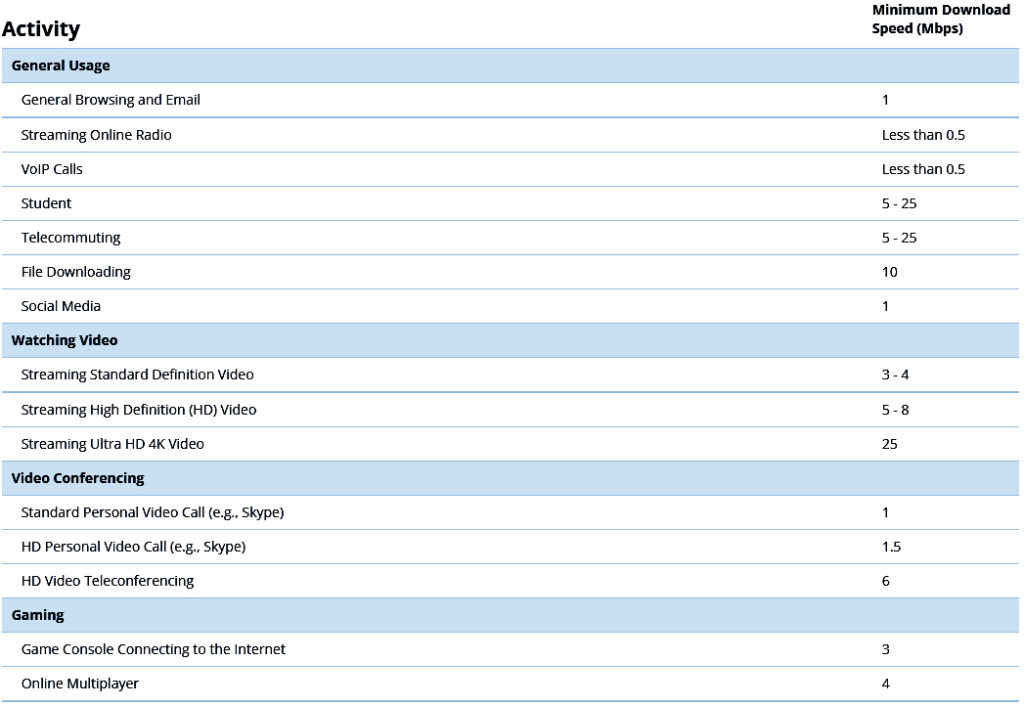
So, based on these recommendations, you can do lots of things with 10 Mbps – you can check email and social media, make VoIP calls, you can easily stream videos in SD and even HD, you can make video conference calls, and you can even play online games.
On the other hand, 10 Mbps is not fast enough for 4K streaming. It also doesn’t match the min recommended speed for telecommuting or learning from home (25 Mbps).
Now that we’ve seen FCC recommendations, let’s check out recommendations given by the streaming services.
Music Streaming
Using music streaming services or listening to online radio is not a problem even with much lower speeds. 10 Mbps will allow you to use just any music streaming service you can think of – Deezer, TIDAL, Spotify, Pandora, Apple Music, etc. Some services, like TIDAL offer streaming in Hi-Res, which requires more than 10 Mbps, so you won’t be able to stream audio files of the highest possible audio quality, but you can still use the service.
So, to conclude, if you use music streaming services or like listening to podcasts, 10 Mbps is more than enough.
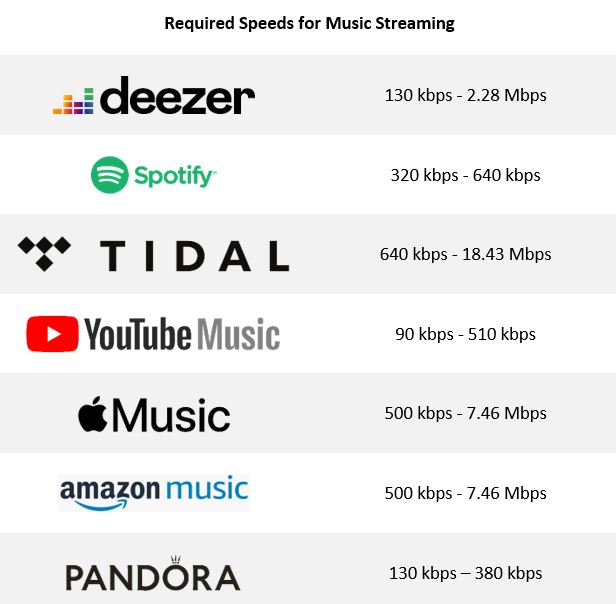
Video Streaming
Video streaming is one of the most common online activities. We all use YouTube every day. Lots of internet users in the US are also subscribed to other video streaming services (Netflix, Hulu, HBO). So, let’s see what those streaming services recommend.
YouTube recommends 2.5 Mbps for 720p, 5 Mbps for 1080p, and 20 Mbps for 4K Ultra HD streaming. With 10 Mbps, you can watch 1080p videos on two devices at the same time or 720p videos on four devices. 10 Mbps is not fast enough for 4K YouTube videos.
Streaming 4K YouTube video with 10 Mbps
https://www.youtube.com/watch?v=NGe4q_VT__Y
Since YouTube has a pretty strong video compression, it’s probably safe to assume that you won’t be able to stream 4K on other streaming platforms. But let’s see.

When it comes to Netflix, your only option is streaming in HD (you can stream on two devices at the same time). For 4K, you need 25 Mbps.
When it comes to Hulu, you need a little bit more for HD streaming (6 Mbps), but 10 Mbps is still enough. 4K Hulu streaming is not possible – you need 16 Mbps.

Amazon Prime Video probably has the strongest and most aggressive video compression of all the streaming services. You need just 3.5 Mbps for HD streaming, which means that you can easily stream on two devices at the same time (maybe even three, with a little bit of luck). 4K streaming, unfortunately, is still not an option – you need 15 Mbps.

HBO GO and HBO Now don’t have 4K content, only HD. You need 5 Mbps for HD streaming, which means that you can stream on two devices simultaneously.

Apple TV+ and Disney+ have the same recommendations – 5 Mbps for HD streaming and 25 for 4K streaming. So, 10 Mbps allows you to stream in HD, but not in 4K.


Live Streams
If your download speed is 10 Mbps and you want to watch live streams, there shouldn’t be any problems. If your internet plan comes with 1 or 2 Mbps upload, then making live streams is not an option. Facebook Live recommends upload speeds of at least 4 Mbps, while Twitch recommends 3-6 Mbps.
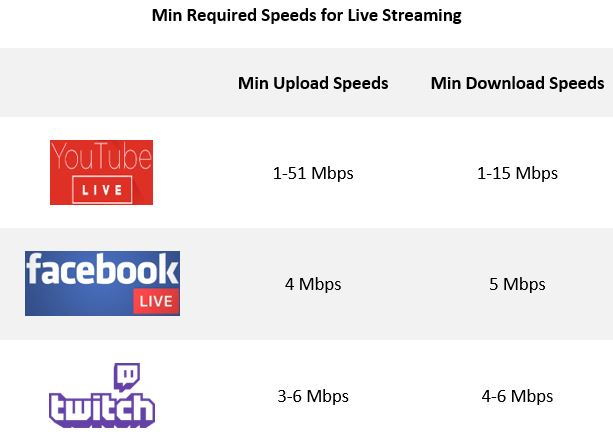
Streaming on Twitch with 10/1 Mbps
Online Gaming
Gaming with 10 Mbps should work, but not always. It may work with some games, but not with others. It may work on some game streaming platforms, but not all.
First of all, when it comes to online gaming, it’s not all about the speeds. For good online gaming experience, you need low latency, low jitter, and no packet loss.
Playing GTA V with 10 Mbps
Latency is measured in ms, and you need it to be very low. Latency is the time necessary for your device to communicate with the server. According to speedtest.net, if it’s under 60ms, you should experience no problems. Even latency under 120ms is not problematic. If the latency is between 120 and 200ms, you may experience some issues. If it’s higher than 200ms, it will be impossible to play any game.
Latency can be fairly consistent, but it can also fluctuate. The fluctuations in latency are called jitter. If the jitter is too high, online gaming will not be smooth. When it comes to gaming, it’s better to have high but constant latency than huge fluctuations.
Recommended reading: Is 12 Mbps Fast?
Finally, if you are about to play an online game, use a wired connection, not Wi-Fi. Wi-Fi is simply less reliable, the speeds are lower, and the latency is higher. Also, if your download speed is just 10 Mbps, it’s smart not to download anything while playing games – you probably don’t have enough bandwidth for both things.
Video Calls and Conferencing
10 Mbps download allows you to receive HQ and HD video calls. You can participate in conference calls in HD on Skype and Zoom. But, the quality of the picture that you will send doesn’t depend on your download – it depends on upload. If you’re using DSL or fixed wireless, then your upload speed is probably 1 or 2 Mbps. That’s good enough for HQ calls on Skype, but not HD calls. When it comes to Zoom, you need 1.2 Mbps for 720p video and 3 Mbps to send video in 1080p.

Final Assessment – Is 10 Mbps Fast or Not?
Well, I guess it depends on who answers the question. I wouldn’t be happy with 10 Mbps – I’ve been on 150/15 Mbps for four years, and I’m mostly happy with my speeds. Moving back to my old 20/2 plan would make me very disappointed, maybe even frustrated. But, if you ask someone who can’t get anything better than 3 Mbps, 10 Mbps is a huge improvement.
Recommended reading:
- Can A Bad Router Cause Slow Internet?
- How to Access Router Settings from Phone
- If You Use Someone’s Wi-Fi, Can They See Your Texts?
We’ve already told you what you can and cannot do with 10 Mbps. It’s not a speed that gives you freedom to use the internet on multiple devices at the same time and do whatever you want. You can watch videos, you can stream music, you can play online games, make video calls, check social media, but you can’t do all those things at once. 10 Mbps is still far from the FCC-recommended benchmark speeds for broadband internet.
In the image below, you can see the estimated download times for files of different sizes when downloaded at 10 Mbps.

FAQ
Q: Is 10 Mbps fast enough for streaming?
A: It depends on what you want to stream. If you want to watch a video on YouTube or a movie on Netflix, then 10 Mbps is good enough, but only for HD videos (10 Mbps is not fast enough for 4K videos). You can also use music streaming platforms, listen to podcasts, or online radio. If you want to create a live stream, then you need good upload speeds. If your upload is 1 or 2 Mbps, then you probably can’t create a decent live stream.
Q: Is 10 Mbps good or bad?
A: It’s not a disaster and it’s definitely better than nothing, but it’s actually not that much. You can do all sorts of things with 10 Mbps – watch HD videos on YouTube and other video streaming platforms, you can stream music, make video calls, etc, but you can’t do all these things simultaneously. You also can’t watch videos in 4K and can’t use some game streaming platforms.
Q: Is 10 Mbps enough for a family?
A: Hardly. Even if you only have just one child. With 10 Mbps, you can watch videos in HD on two devices, and that’s pretty much all you can do. Let’s assume that you’re watching a movie on Netflix in your living room, and your kid is watching some YouTube video in 1080p on his laptop in his room. The moment your kid takes his phone, opens Instagram, and starts scrolling, you will both experience buffering. A family simply requires more bandwidth. If higher speeds are available in your area and if you can afford them, go for 25+ Mbps (ideally 100+ Mbps).
Q: Is 10 Mbps fast enough for YouTube?
A: 10 Mbps is fast enough for YouTube videos in 720p (2.5 Mbps required) or in 1080p (5 Mbps required). With 10 Mbps, you can even watch videos in 1080p on two devices at the same time. However, you can’t watch YouTube videos in 4K.
Q: Is 10 Mbps enough for Zoom?
A: Yes, it is. 10 Mbps download will allow you to receive 1-on-1 and group calls in HD. 3.8 Mbps download is required for HD calls. The quality of video that you will send, however, doesn’t depend on download – it depends on upload. If your upload speed is 10 Mbps, then you don’t have to worry – that’s more than you need for HD calls (3 Mbps recommended for 1080p). But if your upload speed is lower, then you may be able to send video in 720p (1.8 Mbps required) or just HQ (600 kbps).

Hey, I’m Jeremy Clifford. I hold a bachelor’s degree in information systems, and I’m a certified network specialist. I worked for several internet providers in LA, San Francisco, Sacramento, and Seattle over the past 21 years.
I worked as a customer service operator, field technician, network engineer, and network specialist. During my career in networking, I’ve come across numerous modems, gateways, routers, and other networking hardware. I’ve installed network equipment, fixed it, designed and administrated networks, etc.
Networking is my passion, and I’m eager to share everything I know with you. On this website, you can read my modem and router reviews, as well as various how-to guides designed to help you solve your network problems. I want to liberate you from the fear that most users feel when they have to deal with modem and router settings.
My favorite free-time activities are gaming, movie-watching, and cooking. I also enjoy fishing, although I’m not good at it. What I’m good at is annoying David when we are fishing together. Apparently, you’re not supposed to talk or laugh while fishing – it scares the fishes.
